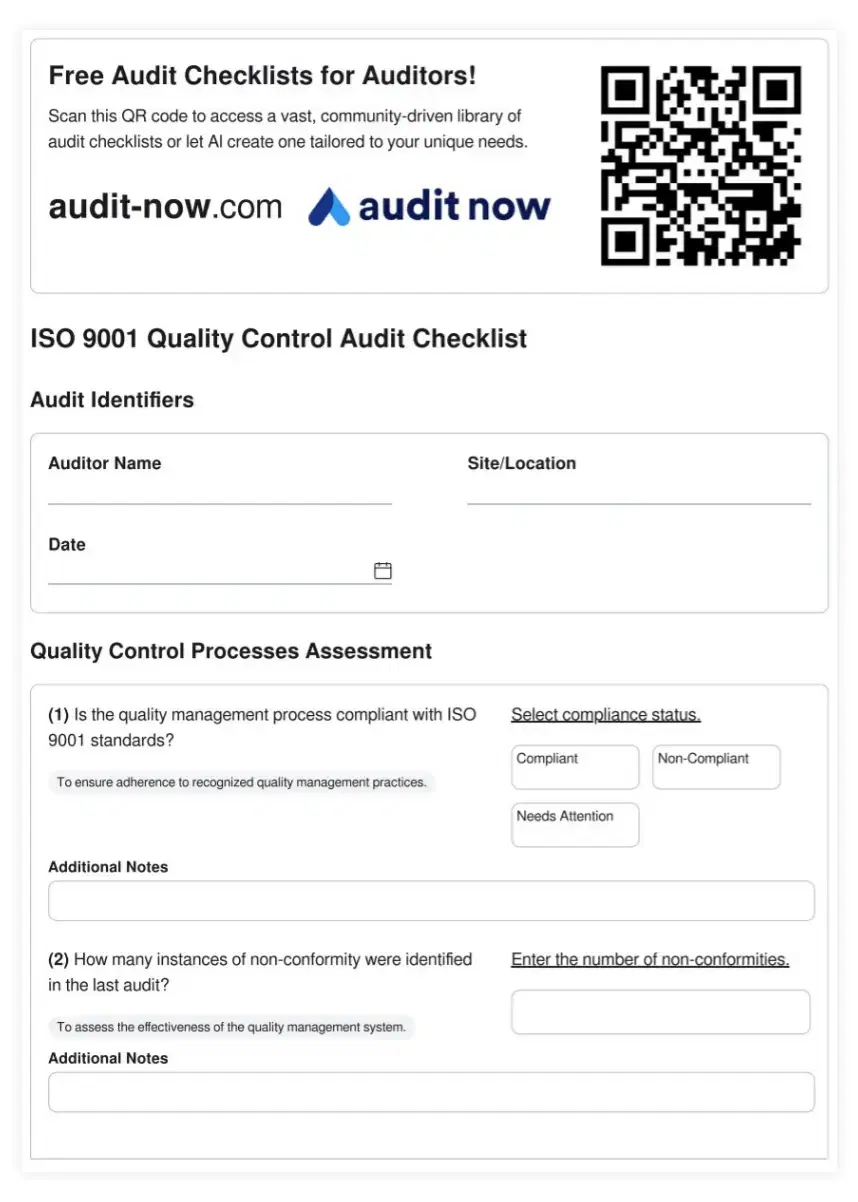Healthcare Facilities: Ensuring Quality Care Through Rigorous Audits

Featured Checklist

Healthcare Financial Management and Billing Compliance Audit Checklist
Effective financial management and billing compliance are critical for the sustainability and integrity of healthcare organizations. The Healthcare Financial Management and Billing Compliance Audit Checklist is an essential tool designed to evaluate adherence to ISO 9001 standards and regulatory requirements in managing healthcare finances and billing processes. This comprehensive checklist addresses key areas such as revenue cycle management, cost control measures, financial reporting accuracy, billing code compliance, insurance claim processing, and patient financial counseling. By systematically assessing these crucial aspects, healthcare organizations can ensure financial stability, reduce billing errors, and maintain compliance with healthcare finance regulations. Regular use of this checklist not only ensures adherence to financial standards but also promotes a culture of fiscal responsibility and continuous improvement in healthcare financial practices.
Understanding Healthcare Facility Audits
Healthcare facility audits are crucial processes that ensure the delivery of high-quality patient care, compliance with regulations, and operational efficiency. These audits encompass various aspects of healthcare operations, from patient safety protocols to infection control measures and documentation practices.
Regular audits help healthcare facilities identify areas for improvement, maintain compliance with industry standards, and ultimately enhance patient outcomes. By systematically evaluating processes, procedures, and documentation, healthcare organizations can proactively address potential issues and continuously refine their practices.
Key Areas of Focus in Healthcare Facility Audits
Patient Safety and Quality of Care
Patient safety is paramount in healthcare settings. Audits in this area typically examine:
- Medication management: Ensuring proper storage, administration, and documentation of medications
- Fall prevention: Assessing protocols and environmental factors to minimize patient falls
- Infection control: Evaluating hand hygiene practices, sterilization procedures, and isolation protocols
- Emergency preparedness: Reviewing disaster response plans and staff training for various scenarios
Compliance and Documentation
Healthcare facilities must adhere to numerous regulations and maintain accurate records. Audits in this domain focus on:
1. Medical record keeping: Assessing completeness, accuracy, and timeliness of patient records
2. HIPAA compliance: Evaluating privacy and security measures for protected health information
3. Licensing and accreditation: Ensuring all necessary certifications and licenses are up-to-date
4. Billing and coding practices: Reviewing accuracy and compliance with reimbursement regulations
Facility Management and Safety
The physical environment plays a crucial role in patient care. Audits in this area examine:
- Equipment maintenance and calibration
- Environmental safety measures (e.g., fire safety, hazardous materials handling)
- Cleanliness and sanitation practices
- Accessibility for patients with disabilities
Core Audit Requirements & Importance of Checklists
Effective healthcare facility audits rely on comprehensive checklists that cover all critical aspects of operations. These checklists serve as roadmaps for auditors, ensuring consistency and thoroughness in the evaluation process.
Key components of healthcare facility audit checklists include:
1. Clearly defined audit objectives: Outlining specific goals for each audit area
2. Detailed evaluation criteria: Establishing measurable standards for assessment
3. Documentation requirements: Specifying necessary records and evidence to be reviewed
4. Observation guidelines: Providing instructions for on-site inspections and staff interviews
5. Scoring system: Implementing a consistent method for rating compliance and performance
The importance of well-designed checklists in healthcare facility audits cannot be overstated. They offer numerous benefits, including:
- Ensuring comprehensive coverage of all relevant areas
- Promoting objectivity and consistency in evaluations
- Facilitating efficient data collection and analysis
- Enabling trend identification and benchmarking over time
- Supporting continuous improvement initiatives
Join Thousands of Satisfied Users
Become part of a community that makes compliance simple and effective.
Try now!
Best Practices for Conducting Healthcare Facility Audits
To maximize the effectiveness of healthcare facility audits, consider the following best practices:
1. Develop a robust audit schedule: Establish a regular cadence for audits, ensuring all areas are covered systematically
2. Assemble skilled audit teams: Include subject matter experts and cross-functional representatives
3. Utilize technology: Implement digital tools for data collection, analysis, and reporting
4. Encourage open communication: Foster a culture of transparency and continuous improvement
5. Provide timely feedback: Share audit results promptly and develop action plans for addressing identified issues
6. Conduct follow-up audits: Verify the implementation and effectiveness of corrective actions
Streamlining Healthcare Facility Audits with Audit Now
Audit Now offers a comprehensive digital solution tailored to the unique operational excellence and auditing needs of healthcare facilities. Our AI-powered platform revolutionizes the audit process, enabling healthcare organizations to conduct more efficient, accurate, and insightful evaluations.
Key features of Audit Now include:
- AI-generated checklists: Customized audit templates based on industry best practices and regulatory requirements
- Real-time collaboration tools: Facilitating seamless communication among audit team members
- Automated reporting: Generating comprehensive audit reports with actionable insights
- Extensive template library: Access to a wide range of pre-built checklists for various healthcare facility audits
To get started with Audit Now:
1. Visit our website at audit-now.com
2. Explore our template library at https://audit-now.com/templates/
3. Generate custom AI checklists at https://audit-now.com/generate-ai-checklist/
4. Sign up for a free trial to experience the full power of our digital audit platform
By leveraging Audit Now's innovative solutions, healthcare facilities can streamline their audit processes, ensure compliance with industry standards, and drive continuous improvement in patient care and operational efficiency.